Puppy training guide – Are you bringing home a new puppy? Puppy training starts on day one!
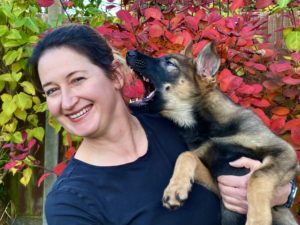
People’s biggest mistake when getting a puppy is allowing the puppy to learn bad habits. Here are a few tips on how to get the most of your puppy training sessions at home:
- Keep training brief. Puppies don’t have a long attention span.
- Start straight away!
- Reward good behaviour.
- Be consistent, so you don’t confuse your pup.
- Keep it fun, and don’t be too strict.

Puppies are sponges and learn things incredibly quickly, so managing their environment is just as important as training them. Your responsibility is not to allow your puppy to go wrong, which means they won’t be learning bad habits.
Things like not letting your puppy chew furniture, not allowing your puppy toilet in the house, do start using their crate (if you are using one) for nap times and create a positive association with being there in the day as well as at night.
All this puppy training starts the very minute you get home. For example, when you arrive home for the first time, do not put your dog down in the living room. They will have been in the car for a while, so take it straight outside and give them a chance to go to the toilet where you want them to.
Learn everything you need to know on our online puppy training course. You don’t need to wait for their vaccinations.
Playing with your puppy – why is playtime so important for puppies?
Training and play are crucial to your puppy’s healthy development. Playing with toys and interacting with you daily helps them to understand some of the basic rules they will need to become a happy, well-adjusted adult dog.
Play sessions should be kept short, ensuring the puppy gets plenty of naps in between. This builds their interest in you from a young age and improves their good behaviour because they have a great outlet.

Playing with your puppy helps with:
- Learning new skills and cues
- To understand that biting and nipping is not acceptable
- To strengthen the bond between you
- To keep them active and learn motor skills
- To ensure they are mentally stimulated
- Keep your pup engaged
Three reasons to train your puppy
- It’s good for their physical and mental wellbeing
- You can spend some quality time together building your bond
- Trained puppies are well-behaved puppies
What are the 7 basic dog commands?
How to train your puppy to sit
Make sure you are in a calm environment on a non-slip floor
- Hold a treat at the end of your fingers
- Place the treat at the end of the puppy’s nose
- Say ‘sit’
- Slowly lure your dog’s nose upwards and backwards, so they shift their weight onto their hindquarters
- As soon as they are in the sit position, praise and give them the treat
How to train your puppy to drop
Use a fun toy that you know your dog likes to hold. Here are two ways to teach your dog to ‘drop’:
Once your dog has hold of the toy in its mouth
- say ‘drop’
- at the same time, drop treats at your feet
- As the dog hoovers up the food, do not take the toy
- Let the dog take the toy again
- Repeat several times
Using a longer toy such as a ball on a rope
- Offer it to your puppy to take in their mouth, but don’t let go of the end of the rope
- Praise your puppy for taking the ball
- Place a treat at the end of your puppy’s nose as you say ‘drop’
- Hold the food there until the puppy lets go of the ball
- Immediately praise the dog and give them the food
- Repeat several times
How to train your puppy to lie down
Hold a treat under your thumb with your palm facing the dog and fingers pointing to the floor
- Say ‘down’
- As you do this, push the palm of your hand on the puppy’s nose in a backwards and downwards motion
- The puppy should fold back into a down position
- Praise and give the treat
How to train your puppy to wait
Once you have mastered sit or down, get the puppy in either of these positions
- Face your puppy and say ‘wait’
- If they stay in the position, reward them with a treat
- Repeat ‘wait’, keep one foot on the ground and with the other foot, move it back as if you were taking a step backwards
- Bring that leg forwards again
- Reward your pup with a treat
- Repeat the above, but this time take a full step back, then a full step forwards before praising and rewarding your pup
How to train your puppy to come
Start this one at home where there are no distractions
- Say your puppy’s name and ‘come’
- As you say this, crouch down and hold a treat in front of you
- Praise them as they eat the treat
- Move backwards and repeat
- As your puppy approaches you take a step or two backward so they learn to approach enthusiastically
How to train your puppy to heel
This will take time so start straight away when you get your puppy. Hand-feed some of their food during short training sessions of just 2-5 mins will be fine
- say ‘heel’
- Use a treat under your thumb, position your hand (on whichever side you want them to walk) to your side with the palm facing down. Make sure you are low enough for your dog to reach up and push your palm with their nose
- As they do this, take some small steps forward
- Let the pup nibble the treat as you walk along
- Repeat many times
- Always do this on the same side, so your pup learns this is the default position for walking
- Over many days/weeks of repetition, you can then start to raise your hand, so your pup learns to follow your hand visually rather than with a food lure
How to train your puppy to give paw
Once your dog has mastered sit get them into a sit position
- Place a treat in the palm of your hand and close it into a fist
- say ‘paw’ as you offer your closed fist in front of your pup at around its chest height
- Ignore any licking or sniffing as your puppy needs to work out what it needs to do
- It will quickly learn that licking and sniffing doesn’t get it anywhere and try other things. When it uses its paw, even if it misses your hand, praise and reward the pup by giving them the treat
- Repeat many times
Check out our video of Copper, one of our Rottweiler puppy clients, on how to train your puppy to give left paw and right paw.
Of course, there are many different ways to teach these, so if this method isn’t working, try watching this video on ‘teach your puppy these 5 basic cues’ or these awesome videos on dog and puppy training. This is also a comprehensive guide that includes some great videos on puppy training 101: your guide to mastering basic puppy training.
Puppy training tips
Puppies learn very quickly and enjoy a well-designed training session. It is essential to keep your sessions fun to make sure you and your puppy get the most out of every exercise, so keep your training sessions short. At first, no more than 2-5 minutes three times a day.
There are many safe and humane ways to teach your puppy how to stop biting, including choosing a selection of different toys to offer them when they are being mouthy. Texture is important to puppies, and you may discover that your puppy prefers fabric toys, for example, or hard plastic toys. Each dog has individual preferences, so observe what they like best and provide plenty of those types of toys for them to play with.
Have you tried a Kong as a chew toy? Kong chews and puppy toys are a fantastic asset to your toy selection as your puppy needs relief from boredom, the pain during teething and mental stimulation. It also gives you a few minutes to get your jobs done, knowing your puppy is happy and out of mischief! Also, have a look at the Kong range of interactive and treat-dispensing toys.
Which toys are best for puppies?
Always choose toys that are appropriate for your puppy’s age and the size of their mouth. Toys should be big enough to prevent swallowing, and always check them regularly for tears or loose parts.
Choose toys that stimulate their curiosity and encourage them to figure something out. Building resilience and problem-solving skills is an excellent outlet for them and help to keep them occupied. This will also encourage them to move, use their limbs and build proprioception.
Remember to give them a variety of different textures to discover, such as:
- A large cardboard box (be careful they don’t swallow the cardboard)
- Puzzle feeders
- Interactive toys and food-based toys
- Rubber toys to allow chewing
- A plastic bottle (take the lid and ring off first)
- A long fabric type toy as some pups like this texture
- Natural chews such as braided lamb chews from JR Pet Products.
Avoid slippery floors with puppies
This is often overlooked and can potentially save you considerable vet bills in future
Many of us have laminate, wood or tiled flooring at home, so here are some great tips from Canine Arthritis Management on dealing with slippery floors. This also explains why it is essential for us to prevent puppy injuries on slippery floors.
Only allow your puppy in rooms without a slippery floor to not injure themselves. You can place down a mosaic of non-slip washable mats. This prevents slips and falls but also are easy to clean in case of a toileting accident.
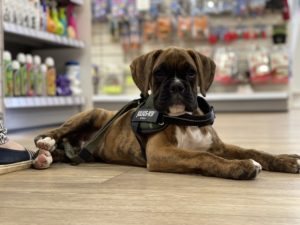
What is the first thing you should train your puppy?
As new puppy parents, the first things you will be training is potty training and crate training. Begin crate training from day one as it gives the puppy a safe, secure place to call its own, which can help with potty training. Dogs don’t like to toilet in their own bedding if they can avoid it.
Let your puppy nap in its crate, and as soon as they wake up, open the crate and take them outside for a toilet opportunity. Begin training your toilet cue, such as ‘wee wee’ as you place the puppy down in the garden. Praise them each time they go.
It is essential to add that an occasional toilet accident is inevitable, but the important thing is not to punish your puppy for this. Never rub its nose in its own wee or poo as they don’t understand what we mean by this at all.
Making a note of the puppy’s training schedule can help get everyone involved whilst ensuring you are not overdoing the obedience training.
Can an 8 week old puppy be potty trained?
Absolutely! A schedule can be helpful for house training or getting through the housebreaking process to help you predict when your puppy may need the toilet. Training your puppy requires plenty of time, so make sure you have the first few weeks free to devote to your pups new forever home.
Begin as you mean to go on, so make sure you start the toilet training from the very first day you bring your puppy home
When should a puppy start training classes?
There are several options: group classes, one to one sessions or online sessions done on video call.
As soon as your puppy has had their vaccinations and are allowed out, you can join a local puppy training class to teach your puppy how to behave in public spaces with other people and dogs around.
Be sure to choose a class that uses positive reinforcement training, which you can find out when you initially enquire. This may also be a nice place to meet other puppy owners.
If you feel a group puppy class would be too distracting, then you could easily find a trainer who teaches you all the basics in a private lesson. This is an excellent way for you and your puppy to learn, as all the training information is specifically for your goals and ability.
Virtual dog training sessions are hugely popular now, and one of the main benefits is that you can start getting help as soon as you get your puppy on all those essential things such as potty training, sleeping at night and settling in your new pup.
You don’t have to wait for vaccinations and put excellent foundations in before you even take your puppy to public places.
Complete Puppy Training Schedule by Age!
Important things to make a note of straight away:
- Register your puppy straight away at a local veterinary practice. You can find a vet practice via RCVS.
- Make sure your puppy is insured. Some vet practices offer 4 week free puppy insurance when you register, so do as for the details. Otherwise, reputable pet insurance companies are Petplan, Bought By Many or specialist insurance for dog owners and breeders through The Kennel Club.
- Flea and tick treatment plan
- Worming plan
- Vaccination dates
- New owner microchip registration
- Plan what food you will want your puppy to be on. Order a small bag and gradually introduce it to their diet after they have been with you and settled for a couple of weeks.
Your New Puppy Training Guide: When to Tackle Each Skill
8-10 weeks
- Settling your new puppy into their new environment
- Crate training
- Basic commands – use play to build engagement
- Potty training
- Do not allow your puppy to learn bad habits!
- Reward good behaviour
- Teach your puppy that you bring all the fun and food. By building this level of engagement from your puppy, you will be on the right track to having a well-behaved dog
- Give them plenty of chew toys
10-12 weeks
- Basic leash training
- Transitioning your puppy onto a new dog food (if you are)
- Teach them how to gently play with a tug toy (do not pull too hard)
- Keep your training sessions short and always end them on a positive note
- Separation training – start being absent or out of sight for a few seconds at a time
- Build impulse control
12-16 weeks
- Improve leash training near your house
- Build on your separation training to slightly longer periods
- You can start to introduce some puppy treats if you need but try and use their puppy food for as long as you can
- Train your dog in a happy voice
- Help your dog learn what they need to do, and don’t assume they will automatically understand
- Teach your puppy how you want them greeting people and reward good manners
- Build your recall over longer distances but always use a long line attached to their harness
16- 24 weeks
- In public spaces, make sure your puppy can come when called
- Teach your puppy to be calm in busy places such as a café or pub
- Make sure they can walk politely on the lead
- Teach your dog impulse control or dog self control
- Keep your puppy engaged even when other dogs are near

Disclaimer: The information provided in this blog is for informational purposes only. Read our full Disclaimer.

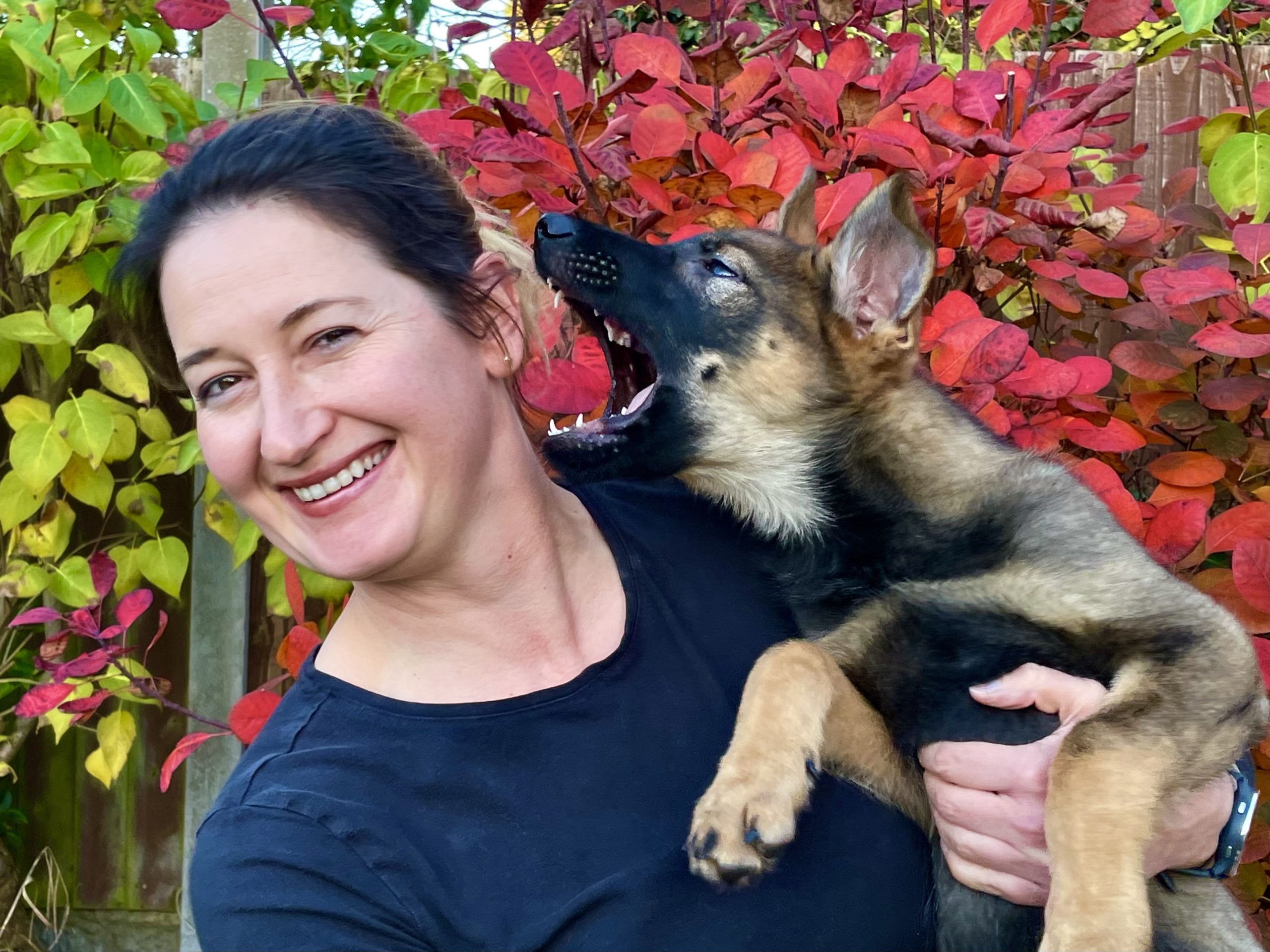



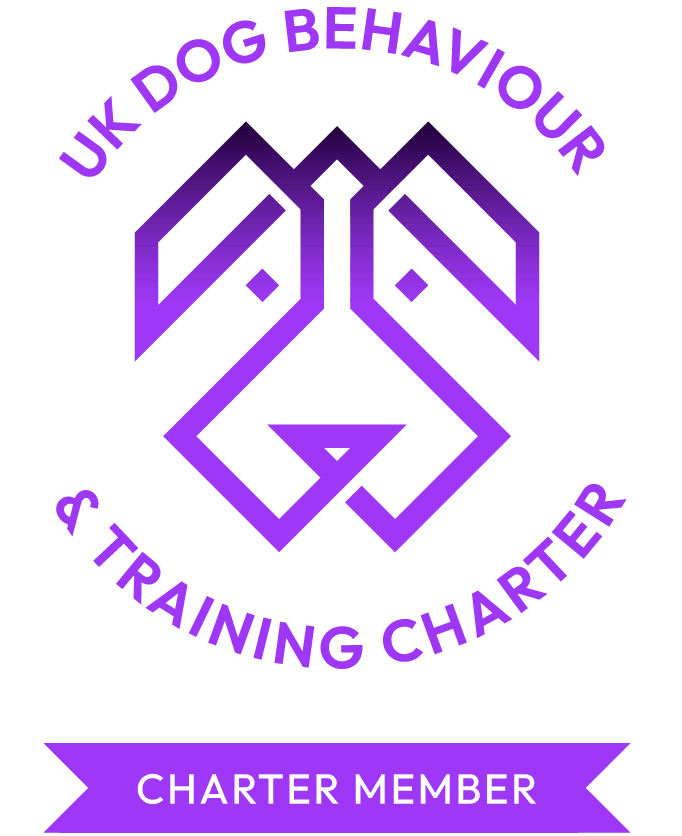
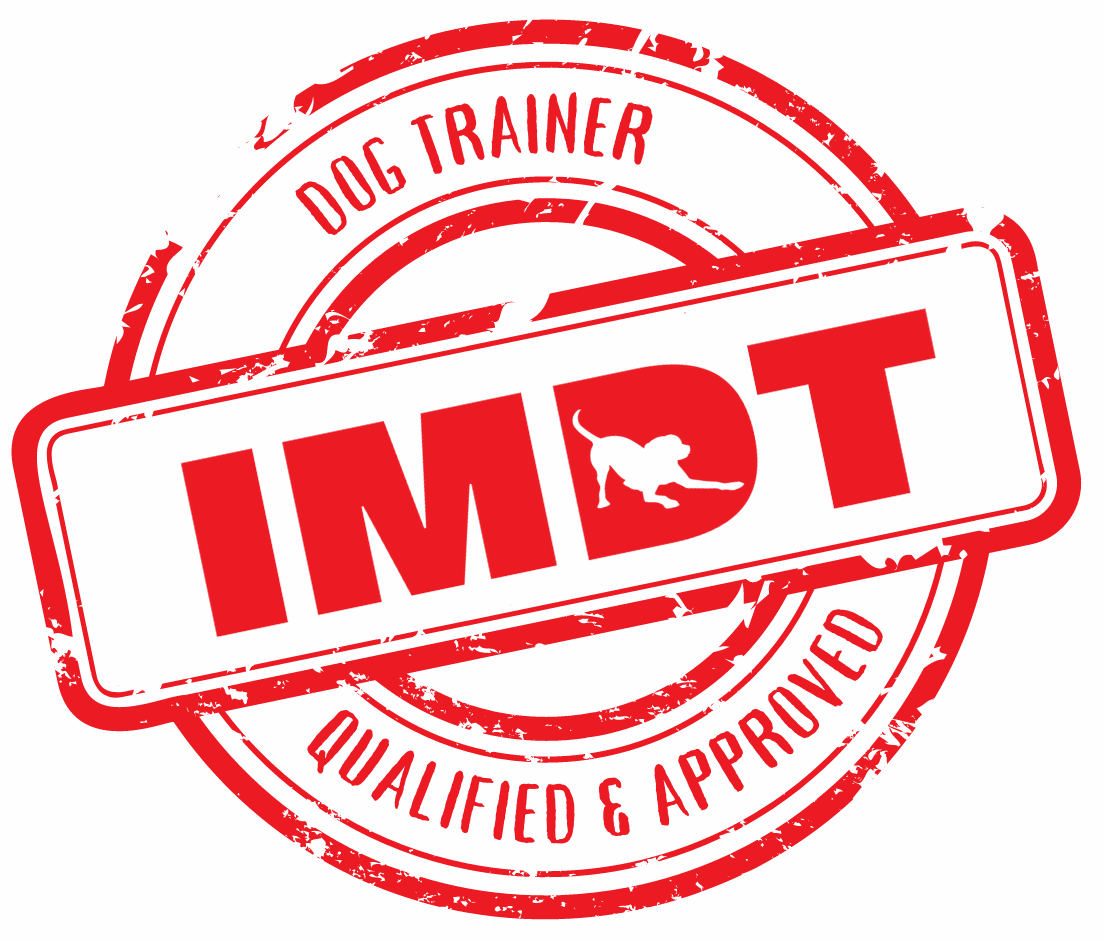
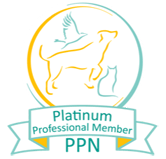

Comments are closed